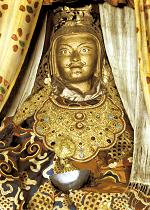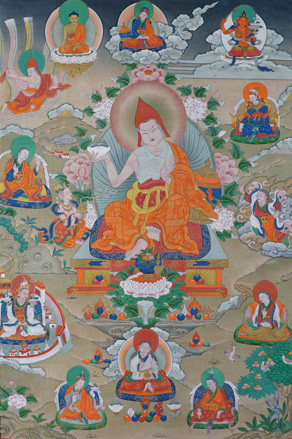Padmasambhava: Difference between revisions
mNo edit summary |
mNo edit summary |
||
| Line 1: | Line 1: | ||
[[Image:Guru ngadrama.JPG|frame|The famous '[[Looks Like Me]]' statue of Guru Padmasambhava]] | [[Image:Guru ngadrama.JPG|frame|The famous '[[Looks Like Me]]' statue of Guru Padmasambhava]] | ||
'''Padmasambhava''' (Skt.), or '''Padmakara''' (Skt. '' | '''Padmasambhava''' (Skt.), or '''Padmakara''' (Skt. ''Padmākara''; Tib. ''Pemajungné''; [[Wyl.]] ''pad+ma 'byung gnas'') means ‘Lotus-Born’, which refers to Guru Rinpoche's birth from a lotus in the land of [[Oddiyana]]. '''Guru Rinpoche''', the ‘Precious Master’, is the founder of [[Tibetan Buddhism]] and the [[Buddha]] of our time. Whereas Buddha is known primarily for having taught the teachings of the [[sutra]] vehicle, Padmasambhava came into this world, and to Tibet in particular, in order to teach the [[tantra]]s. While [[Buddha Shakyamuni]] exemplifies the buddha principle, the most important element in the [[sutrayana]] path, Padmasambhava personifies the guru principle, the heart of [[Vajrayana]] Buddhism, and he is therefore known as the ‘second Buddha’ (Tib. ''sangyé nyipa''). | ||
==Biographies== | ==Biographies== | ||
Revision as of 07:08, 27 May 2009

Padmasambhava (Skt.), or Padmakara (Skt. Padmākara; Tib. Pemajungné; Wyl. pad+ma 'byung gnas) means ‘Lotus-Born’, which refers to Guru Rinpoche's birth from a lotus in the land of Oddiyana. Guru Rinpoche, the ‘Precious Master’, is the founder of Tibetan Buddhism and the Buddha of our time. Whereas Buddha is known primarily for having taught the teachings of the sutra vehicle, Padmasambhava came into this world, and to Tibet in particular, in order to teach the tantras. While Buddha Shakyamuni exemplifies the buddha principle, the most important element in the sutrayana path, Padmasambhava personifies the guru principle, the heart of Vajrayana Buddhism, and he is therefore known as the ‘second Buddha’ (Tib. sangyé nyipa).
Biographies
There are many accounts of Guru Rinpoche’s life, written by great scholars or revealed by the tertöns. Some of the most famous of his biographies are the Namthar Zanglingma, ‘The Zanglingma Lifestory’, named after the Copper Temple at Samyé where it was discovered as a terma by Nyangrel Nyima Özer, the Pema Kathang or Namthar Sheldrakma, ‘The Life-Story from the Crystal Cave’, revealed by Orgyen Lingpa, the Kathang Serthreng ‘Golden Garland Chronicles’ discovered by Sangyé Lingpa, and the Namthar Yikyi Münsel, ‘The Life-Story that Dispels Mind’s Darkness’, by Sokdokpa Lodrö Gyaltsen. Guru Rinpoche’s life is also recorded in the histories of the different teaching cycles; there exists a famous Indian version compiled by Jetsün Taranatha, and biographies are even to be found in the Bön tradition of Tibet.
Writings
- The Garland of Views: An Instruction (Wyl. man ngag lta ba'i phreng ba)
Students
As One of the Eight Manifestations of Guru Rinpoche

From A Great Treasure of Blessings, page 32.
- The King of Tibet, Trisong Detsen, had invited the great pandita Shantarakshita to establish Buddhism in his country. Shantarakshita began teaching in Tibet and laid the foundations for Samyé Monastery. This provoked the local spirits, who embarked on a campaign of disasters—disease, floods, storms, hail, famine and drought—and whatever construction work was done at Samyé during the day was dismantled at night. Shantarakshita urged the King to invite Padmasambhava.
- On the way to Tibet, he began to subjugate the local spirits and made them take oaths to protect the Dharma and its followers. He brought all the 'gods and demons' of Tibet under his command. Samyé was then built without any hindrance, completed within five years, and consecrated.
Further Reading
- Nyoshul Khenpo, A Marvelous Garland of Rare Gems: Biographies of Masters of Awareness in the Dzogchen Lineage, trans. Richard Barron (Junction City: Padma Publishing, 2005), pages 41–48.
- ‘The Life of Guru Padmasambhava’ in A Great Treasure of Blessings, The Tertön Sogyal Trust, 2004.
- Ngawang Zangpo, Guru Rinpoche: His Life and Times, Snow Lion, 2002.
- Tulku Thondup, Masters of Meditation and Miracles, Shambhala, 1996.
Dudjom Rinpoche, The Nyingma School of Tibetan Buddhism, trans. and ed. by Gyurme Dorje and Matthew Kapstein (Boston: Wisdom Publications, 1991), vol. 1, pages 468–474.